|
Investors viewed the Group of 20 meeting at first with trepidation and then optimism as the meeting drew closer. At issue was whether the leaders would agree to measures to fight the global recession. And markets worldwide surged Thursday as world leaders agreed to a sweeping package of measures to fight the global recession, including a $250 billion increase in the international money supply and a pledge to give a $500 billion boost to the International Monetary Fund to help struggling emerging economies. Much of the total $1 trillion pledged to help the world recover from recession represented existing commitments or pledges of future funds that had not been pinned down.
The new development which will boost foreign exchange reserves of every country was to let the IMF create $250 billion of Special Drawing Rights (SDRs), a currency basket based on the dollar, euro, yen and sterling. This is the equivalent of quantitative easing on the global scale. The IMF will create the new $250 billion and will allocate this according to the voting shares its 186 members have in the Fund.
The equity rally continued despite Monday’s blow when the U.S. government decided to get tough with Detroit. But other factors more than offset that negative as data continued to support the thesis that the steep decline for the world economy is slowing, even if recovery is not in sight. Also helping was a decision by the U.S. Financial Accounting Standards Board (FASB) which gives banks far more leeway over how they should price “toxic” assets on their balance sheets.
There was also only a muted impact from the Bank of Japan’s Tankan survey of business sentiment that set new record lows but met analysts’ expectations. The main index fell to a new low, but analysts said the outlook was improving.
All equity indexes covered here with the exception of the KLSE Composite were up for the month of March. Gains for the month ranged from 14.3 percent for the Taiex, 13.9 percent for the Shanghai Composite and 13.5 percent for the Kospi to 2.2 percent for the Topix. The SET was unchanged on the month. Six indexes — all in the Asia/Pacific region — were up for the first quarter. Gains ranged from 30.3 percent (Shanghai Composite) to 0.6 percent for the Sensex. First quarter losses ranged from 15.1 percent (DAX) to 0.5 percent for the KLSE Composite.
For global equities, March came in like a bear and went out a bull as many indexes were up for the first month this year and eased some of the pain associated with a horrible first quarter. The turning point for equities came in early March with financial stocks, which had been heavily sold, leading the rebound.
|
|
2008 |
2009 |
% Change |
|
Index |
Dec 31 |
Mar 27 |
Apr 3 |
Week |
Q1 |
Year |
| Asia |
|
|
|
|
|
|
|
| Australia |
All Ordinaries |
3659.3 |
3615.6 |
3674.0 |
1.6% |
-3.5% |
0.4% |
| Japan |
Nikkei 225 |
8859.6 |
8627.0 |
8749.8 |
1.4% |
-8.5% |
-1.2% |
|
Topix |
859.2 |
824.5 |
831.4 |
0.8% |
-10.0% |
-3.2% |
| Hong Kong |
Hang Seng |
14387.5 |
14119.5 |
14545.7 |
3.0% |
-5.6% |
1.1% |
| S. Korea |
Kospi |
1124.5 |
1237.5 |
1283.8 |
3.7% |
7.3% |
14.2% |
| Singapore |
STI |
1761.6 |
1745.7 |
1820.9 |
4.3% |
-3.5% |
3.4% |
| China |
Shanghai Composite |
1820.8 |
2374.4 |
2419.8 |
1.9% |
30.3% |
32.9% |
|
|
|
|
|
|
|
|
| India |
Sensex 30 |
9647.3 |
10048.5 |
10348.8 |
3.0% |
0.6% |
7.3% |
| Indonesia |
Jakarta Composite |
1355.4 |
1462.7 |
1500.4 |
2.6% |
5.8% |
10.7% |
| Malaysia |
KLSE Composite |
876.8 |
885.4 |
907.0 |
2.4% |
-0.5% |
3.5% |
| Philippines |
PSEi |
1872.9 |
2040.3 |
2028.6 |
-0.6% |
6.1% |
8.3% |
| Taiwan |
Taiex |
4591.2 |
5390.7 |
5529.6 |
2.6% |
13.5% |
20.4% |
| Thailand |
SET |
450.0 |
440.8 |
446.0 |
1.2% |
-4.1% |
-0.9% |
|
|
|
|
|
|
|
|
| Europe |
|
|
|
|
|
|
|
| UK |
FTSE 100 |
4434.2 |
3898.9 |
4029.7 |
3.4% |
-11.2% |
-9.1% |
| France |
CAC |
3218.0 |
2840.6 |
2958.7 |
4.2% |
-12.8% |
-8.1% |
| Germany |
XETRA DAX |
4810.2 |
4203.6 |
4385.0 |
4.3% |
-15.1% |
-8.8% |
|
|
|
|
|
|
|
|
| North America |
|
|
|
|
|
|
|
| United States |
Dow |
8776.4 |
7776.2 |
8017.6 |
3.1% |
-13.3% |
-8.6% |
|
NASDAQ |
1577.0 |
1545.2 |
1621.9 |
5.0% |
-3.1% |
2.8% |
|
S&P 500 |
903.3 |
815.9 |
842.5 |
3.3% |
-11.7% |
-6.7% |
| Canada |
S&P/TSX Comp. |
8987.7 |
8821.1 |
9065.8 |
2.8% |
-3.0% |
0.9% |
| Mexico |
Bolsa |
22380.3 |
20315.2 |
20933.8 |
3.0% |
-12.3% |
-6.5% |
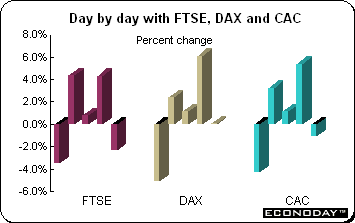 European and British stocks declined on Friday, in part due to profit taking and in part due to the dreadful U.S. employment report. Nevertheless, the FTSE along with the DAX and CAC recorded healthy gains for the week. Earlier in the week, better than anticipated U.S. housing and manufacturing data buoyed investor sentiment. And financial shares rallied after FASB agreed to relax its mark-to-market accounting rules that requires banks to revalue assets each quarter to reflect market prices. Writedowns and credit-related losses at financial institutions have swelled to an estimated $1.29 trillion since the start of 2007. European and British stocks declined on Friday, in part due to profit taking and in part due to the dreadful U.S. employment report. Nevertheless, the FTSE along with the DAX and CAC recorded healthy gains for the week. Earlier in the week, better than anticipated U.S. housing and manufacturing data buoyed investor sentiment. And financial shares rallied after FASB agreed to relax its mark-to-market accounting rules that requires banks to revalue assets each quarter to reflect market prices. Writedowns and credit-related losses at financial institutions have swelled to an estimated $1.29 trillion since the start of 2007.
Equities were up — especially on Thursday — after G20 leaders in London pledged to do “whatever necessary” to end the global economic crisis. They called for stricter limits on hedge funds, executive pay, credit rating companies and risk-taking by banks and pledged more than $1 trillion in emergency aid to fight the economic crisis.
The three indexes were up in March with the DAX leading the way with a monthly increase of 6.3 percent. It was followed by the CAC which recorded a 3.9 percent gain while the FTSE was up a more modest 2.8 percent. However, for the first quarter, the indexes lost 15.1 percent, 12.7 percent and 11.2 percent respectively.
 The European Central Bank cut its key interest rate by 25 basis points to 1.25 percent instead of the 50 basis points that some analysts expected. The official rate is at its lowest since the euro was launched in 1999. The ECB has now lowered interest rates a total of 300 basis points. The European Central Bank cut its key interest rate by 25 basis points to 1.25 percent instead of the 50 basis points that some analysts expected. The official rate is at its lowest since the euro was launched in 1999. The ECB has now lowered interest rates a total of 300 basis points.
The economic data from the region have been uniformly dreadful with exports and industrial production plummeting. Germany has been particularly hard hit by the export decline since foreign demand contributes a sizable portion of its GDP. The 25 basis point cut allows the ECB to keep all key interest rates in positive territory while maintaining a 100 basis point corridor between the refinance and deposit rates. Several governing council members have previously said that 1 percent is the absolute floor for the main refinance rate. With rate cuts nearly exhausted, attention will naturally shift towards alternative measures.
In his prepared statement, ECB President Jean Claude Trichet did not announce any new nonstandard monetary policy measures — however, he did point to the May 7 meeting as a time when nonstandard policy measures will be considered and decided. The ECB has become increasingly concerned about the depth and duration of the recession. It is already the worst seen in continental Europe since the second world war. And although inflation, now at 0.6 percent on the year, is well below the ECB’s 2 percent target, Trichet has previously voiced the widespread concern among ECB governing council members that zero interest rates create damaging economic distortions. Mr Trichet told a press conference after Thursday’s rate announcement that the ECB would say after its meeting next month what additional measures it would take to boost the economy. So far, the ECB’s efforts have focused on “enhanced credit support.” The ECB has provided banks with unlimited amounts of liquidity.
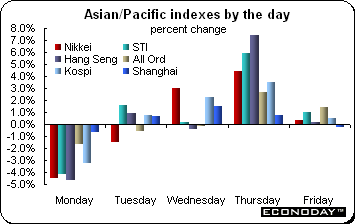 Asian/Pacific indexes with the exception of the Philippine PSEi were up again last week, extending gains on expectations that the worst had been overcome and the global economy, though still weak, is no longer in free-fall. Investors here were positive after G20’s promise of about $1.1 trillion in loans and guarantees and a relaxation in the “mark-to-market” accounting rules for banks by FASB. Automakers, resources and financials were the major gainers. However, profit taking ahead of the weekend limited the gains. Asian/Pacific indexes with the exception of the Philippine PSEi were up again last week, extending gains on expectations that the worst had been overcome and the global economy, though still weak, is no longer in free-fall. Investors here were positive after G20’s promise of about $1.1 trillion in loans and guarantees and a relaxation in the “mark-to-market” accounting rules for banks by FASB. Automakers, resources and financials were the major gainers. However, profit taking ahead of the weekend limited the gains.
As the first quarter ended on March 31, six of 13 indexes were positive — Shanghai Composite (up 30.3 percent), Taiex (up 13.5 percent), Kospi (up 7.3 percent), PSEi (up 6.1 percent), Jakarta Composite (up 5.8 percent) and the Sensex (up 0.6 percent). Most of the gains were in the month of March, where all indexes with the exception of the KLSE Composite were up for the month.
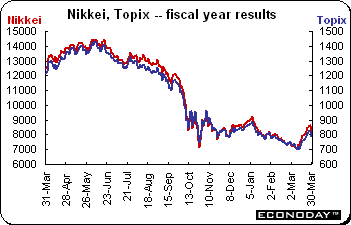 For those looking for a ray of sunshine in economic data they did not find it in Japan where industrial production continued to plummet and the Tankan set record low readings. Producers did predict that production would increase in March however — but that is after three consecutive monthly declines of about 10 percent each. Stocks were up anyhow on the week thanks to a weaker yen which helped exporter stocks rise. The Nikkei and Topix were down 8.5 percent and 10 percent respectively in the first quarter despite posting hefty gains of 7.2 percent and 2.2 percent in March. For those looking for a ray of sunshine in economic data they did not find it in Japan where industrial production continued to plummet and the Tankan set record low readings. Producers did predict that production would increase in March however — but that is after three consecutive monthly declines of about 10 percent each. Stocks were up anyhow on the week thanks to a weaker yen which helped exporter stocks rise. The Nikkei and Topix were down 8.5 percent and 10 percent respectively in the first quarter despite posting hefty gains of 7.2 percent and 2.2 percent in March.
The Japanese fiscal year 2008 ended on March 31. It was a year that saw the economy plunge into an abyss — GDP plummeted in the first three quarters and the latest quarter is expected to be even worse. Industrial production swooned on the heels of sinking exports and the global recession dried up markets for exporters’ goods. And the yen rose in value, especially from October 2008 through January when risk aversion was at its peak. However, the currency was little changed from its previous fiscal year end.
The Bank of Japan, which meets the first two days of this week, said that the March monetary base was up 6.9 percent on the year to ¥94.46 trillion yen up from ¥93.65 trillion in February. On a seasonally adjusted basis, the monetary base was up 5.6 percent on the month at ¥94.3 trillion.
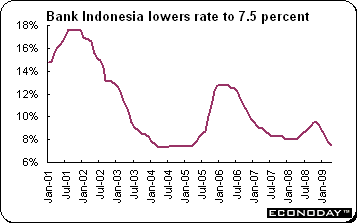 Bank Indonesia reduced its reference interest rate to 7.5 percent from 7.75 percent. In reducing rates for a fifth month, the Bank said that it has room to cut borrowing costs further to help boost consumer spending. Central banks around Asia have slashed borrowing costs to shield their export-dependent economies from the global financial crisis. The Indonesian government has also unveiled a stimulus package worth 1.3 percent of gross domestic product to bolster an economy growing at the weakest pace in eight years. Bank Indonesia reduced its reference interest rate to 7.5 percent from 7.75 percent. In reducing rates for a fifth month, the Bank said that it has room to cut borrowing costs further to help boost consumer spending. Central banks around Asia have slashed borrowing costs to shield their export-dependent economies from the global financial crisis. The Indonesian government has also unveiled a stimulus package worth 1.3 percent of gross domestic product to bolster an economy growing at the weakest pace in eight years.
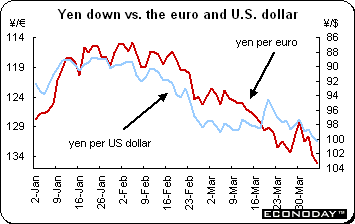 The yen sank against the U.S. dollar, the euro and other major counterparts last week on optimism that the worst of the global financial crisis may be over soon and reduce demand for the currency as a safe haven. The yen is at its lowest level since October when it last traded at ¥100 to the U.S. dollar. Dollar and yen weakness was the result of the rising appetite for risk. Analysts said the US employment report, which showed 663,000 jobs were lost outside the agricultural sector last month, did little to dent sentiment as it was in line with consensus forecasts. The yen sank against the U.S. dollar, the euro and other major counterparts last week on optimism that the worst of the global financial crisis may be over soon and reduce demand for the currency as a safe haven. The yen is at its lowest level since October when it last traded at ¥100 to the U.S. dollar. Dollar and yen weakness was the result of the rising appetite for risk. Analysts said the US employment report, which showed 663,000 jobs were lost outside the agricultural sector last month, did little to dent sentiment as it was in line with consensus forecasts.
The euro was up Thursday against the dollar after the European Central Bank cut the main refinancing rate by less than forecast and deferred a decision on what other tools it can use to rescue its ailing economy. In comments following the ECB’s decision, ECB President Jean Claude Trichet signaled that there is still room to cut interest rates for the eurozone and said the world economy is undergoing a severe downturn.
The dollar also lost ground against the pound with credit surveys in the UK showing increased availability of lendable funds. Traders largely shrugged off the U.S. Labor Department's disappointing jobless claims data and focused on new orders for manufactured goods instead, which increased by more than expected.
Selected currencies — weekly results
|
|
2008 |
2009 |
% change |
|
|
Dec 31 |
Mar 27 |
Apr 3 |
Week |
2009 |
| U.S. $ per currency |
|
|
|
|
|
|
| Australia |
A$ |
0.686 |
0.693 |
0.716 |
3.3% |
0.7% |
| New Zealand |
NZ$ |
0.579 |
0.570 |
0.587 |
2.9% |
-0.1% |
| Canada |
C$ |
0.819 |
0.808 |
0.813 |
0.6% |
-1.1% |
| Eurozone |
euro (€) |
1.405 |
1.330 |
1.349 |
1.4% |
-3.4% |
| UK |
pound sterling (£) |
1.467 |
1.430 |
1.482 |
3.7% |
1.6% |
|
|
|
|
|
|
|
| Currency per U.S. $ |
|
|
|
|
|
|
| China |
yuan |
6.841 |
6.833 |
6.835 |
0.0% |
-0.1% |
| Hong Kong |
HK$* |
7.750 |
7.750 |
7.750 |
0.0% |
0.0% |
| India |
rupee |
48.435 |
50.575 |
50.395 |
0.4% |
-3.4% |
| Japan |
yen |
90.607 |
97.932 |
100.270 |
-2.3% |
-9.5% |
| Malaysia |
ringgit |
3.479 |
3.635 |
3.538 |
2.8% |
-2.4% |
| Singapore |
Singapore $ |
1.450 |
1.514 |
1.505 |
0.6% |
-4.8% |
| South Korea |
won |
1299.550 |
1351.450 |
1332.575 |
1.4% |
-5.5% |
| Taiwan |
Taiwan $ |
33.050 |
33.769 |
33.340 |
1.3% |
-1.6% |
| Thailand |
baht |
34.975 |
35.361 |
35.280 |
0.2% |
-1.5% |
| Switzerland |
Swiss franc |
1.068 |
1.143 |
1.131 |
1.1% |
-5.8% |
|
|
|
|
|
|
|
| *Pegged to U.S. dollar |
|
|
|
|
|
|
| Source: Bloomberg |
|
|
|
|
|
|
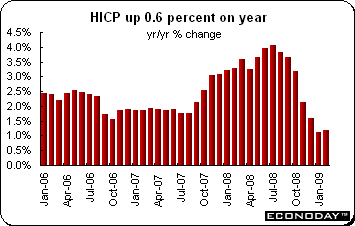 March flash harmonized index of consumer prices slowed to an increase of 0.6 percent on the year from 1.2 percent in the previous month. As usual, there were few details released in the flash report but national data showed widespread declines in inflation. March flash harmonized index of consumer prices slowed to an increase of 0.6 percent on the year from 1.2 percent in the previous month. As usual, there were few details released in the flash report but national data showed widespread declines in inflation.
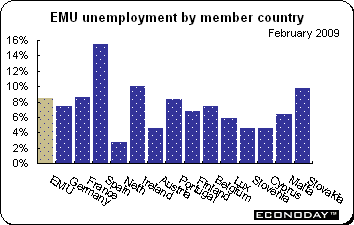 February joblessness rose by a further 319,000 to 13.486 million and lifted the unemployment rate from an upwardly revised 8.3 percent to a 33-month high at 8.5 percent. The jobless rate has now risen every month since August 2008 and stands 1.1 percentage above its year ago level. With the exception of the Netherlands where the rate remained unchanged and the lowest across the region at 2.7 percent, unemployment climbed in all member states. February joblessness rose by a further 319,000 to 13.486 million and lifted the unemployment rate from an upwardly revised 8.3 percent to a 33-month high at 8.5 percent. The jobless rate has now risen every month since August 2008 and stands 1.1 percentage above its year ago level. With the exception of the Netherlands where the rate remained unchanged and the lowest across the region at 2.7 percent, unemployment climbed in all member states.
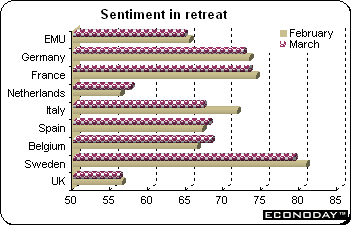 March economic sentiment declined to 64.6 from a marginally higher revised February level of 65.3 but the latest decline left confidence at a new record low. With the exception of retail, all sectors saw morale hit new all time troughs. Industry was down a further 5 points to minus 38 while services and consumers both lost another point to minus 25 and minus 34 respectively. However, retail edged a notch higher to minus 18 and construction was unchanged at minus 32. March economic sentiment declined to 64.6 from a marginally higher revised February level of 65.3 but the latest decline left confidence at a new record low. With the exception of retail, all sectors saw morale hit new all time troughs. Industry was down a further 5 points to minus 38 while services and consumers both lost another point to minus 25 and minus 34 respectively. However, retail edged a notch higher to minus 18 and construction was unchanged at minus 32.
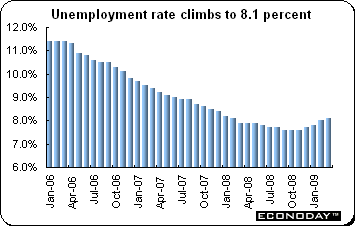 March joblessness rose a further 69,000 and lifted the unemployment rate to 8.1 percent from a slightly higher revised 8.0 percent in the previous month. The latest increase took the number out of work to 3,401,000. Vacancies fell another 15,000 on the month. March joblessness rose a further 69,000 and lifted the unemployment rate to 8.1 percent from a slightly higher revised 8.0 percent in the previous month. The latest increase took the number out of work to 3,401,000. Vacancies fell another 15,000 on the month.
 February seasonally adjusted retail sales excluding autos edged down 0.2 percent and were down 1.1 percent when compared with last year. On an unadjusted basis, all major categories were down on the year with declines ranging from 6.6 percent for non-specialty stores and 8.4 percent for mail order to a drop of 3.1 percent for clothing and shoes. February seasonally adjusted retail sales excluding autos edged down 0.2 percent and were down 1.1 percent when compared with last year. On an unadjusted basis, all major categories were down on the year with declines ranging from 6.6 percent for non-specialty stores and 8.4 percent for mail order to a drop of 3.1 percent for clothing and shoes.
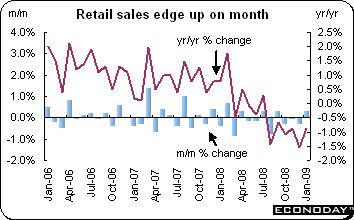 January seasonally adjusted retail sales edged up 0.3 percent but were down 0.9 percent when compared with last year. The entire monthly rise was attributable to the non-food sector where purchases were up a respectable 0.5 percent. Food sales however were down 0.3 percent. January seasonally adjusted retail sales edged up 0.3 percent but were down 0.9 percent when compared with last year. The entire monthly rise was attributable to the non-food sector where purchases were up a respectable 0.5 percent. Food sales however were down 0.3 percent.
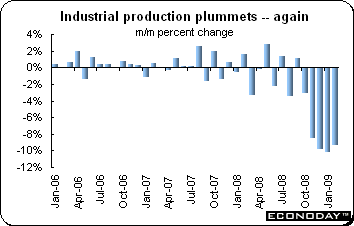 February industrial production sank 9.4 percent and is now down 37.7 percent on the year. In each of the last four months output has declined more than 8.5 percent – it set a record in January by plunging 10.2 percent from December. The main industries that declined were transport equipment, general machinery and electrical machinery. Commodities that declined included both large and small passenger cares and chassis and body parts. The industrial output release also contains a forecast for the next month’s data. According to the Survey of Production Forecast in Manufacturing, production is expected to turn around and to increase 2.9 percent in March and to increase 3.1 percent in April. February industrial production sank 9.4 percent and is now down 37.7 percent on the year. In each of the last four months output has declined more than 8.5 percent – it set a record in January by plunging 10.2 percent from December. The main industries that declined were transport equipment, general machinery and electrical machinery. Commodities that declined included both large and small passenger cares and chassis and body parts. The industrial output release also contains a forecast for the next month’s data. According to the Survey of Production Forecast in Manufacturing, production is expected to turn around and to increase 2.9 percent in March and to increase 3.1 percent in April.
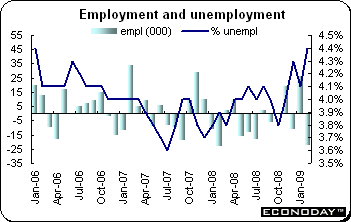 February unemployment edged upward to 4.4 percent from 4.1 percent in January. The number of unemployment persons increased by 330,000 or 12.4 percent on the year. Employment dropped by 270,000 when compared with last year with the employment rate declining to 56.7 percent. The labour force participation rate was unchanged at 59.4 percent. Sinking exports and industrial production continue to negatively impact employment as manufacturers try to reduce their inventory over-hang. February unemployment edged upward to 4.4 percent from 4.1 percent in January. The number of unemployment persons increased by 330,000 or 12.4 percent on the year. Employment dropped by 270,000 when compared with last year with the employment rate declining to 56.7 percent. The labour force participation rate was unchanged at 59.4 percent. Sinking exports and industrial production continue to negatively impact employment as manufacturers try to reduce their inventory over-hang.
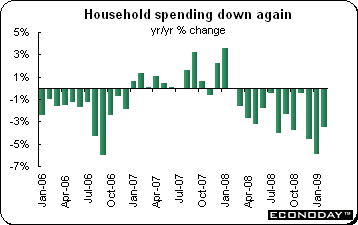 February household spending declined by 3.5 percent when compared with the previous year after dropping 5.9 percent in January. This was the 12th straight month of decline. On the year, real spending was down in nine of the 10 categories led by a 15.0 percent decline furniture & household utensils, a 12.9 percent drop in clothing & footwear and 10.4 percent swoon in medical care. Transportation & communication spending rebounded by 15.7 percent after sinking 15.4 percent on the year in January. February household spending declined by 3.5 percent when compared with the previous year after dropping 5.9 percent in January. This was the 12th straight month of decline. On the year, real spending was down in nine of the 10 categories led by a 15.0 percent decline furniture & household utensils, a 12.9 percent drop in clothing & footwear and 10.4 percent swoon in medical care. Transportation & communication spending rebounded by 15.7 percent after sinking 15.4 percent on the year in January.
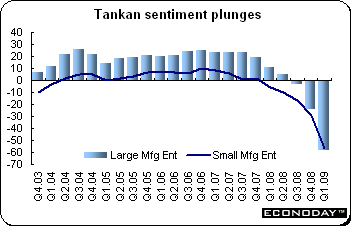 First quarter Tankan lived up to its advance billing as truly being dreadful. As expected, sentiment among manufacturers, both large and small, drastically worsened as the global financial crisis took a severe toll on the real economy. The large manufacturer diffusion index sank to minus 58 from minus 24 in the previous quarter. This was the sixth consecutive quarter that sentiment has deteriorated. The index for small manufacturers plunged to minus 57 from minus 29. The readings represent the percentage of companies saying business conditions are good minus those saying conditions are bad. Sentiment among large non-manufacturers also deteriorated to minus 31 from minus 9 in December. An important reading for analysts is the fixed investment or CAPEX index. This index is at its lowest since 2002. Large manufacturers’ capital spending for the next fiscal year to March 31, 2010 is forecast to drop 13.2 percent from a year earlier. But spending by all large firms is expected to slip 6.6 percent. All small enterprise firms’ capital investment plans are expected to plunge 35.6 percent from a year earlier. First quarter Tankan lived up to its advance billing as truly being dreadful. As expected, sentiment among manufacturers, both large and small, drastically worsened as the global financial crisis took a severe toll on the real economy. The large manufacturer diffusion index sank to minus 58 from minus 24 in the previous quarter. This was the sixth consecutive quarter that sentiment has deteriorated. The index for small manufacturers plunged to minus 57 from minus 29. The readings represent the percentage of companies saying business conditions are good minus those saying conditions are bad. Sentiment among large non-manufacturers also deteriorated to minus 31 from minus 9 in December. An important reading for analysts is the fixed investment or CAPEX index. This index is at its lowest since 2002. Large manufacturers’ capital spending for the next fiscal year to March 31, 2010 is forecast to drop 13.2 percent from a year earlier. But spending by all large firms is expected to slip 6.6 percent. All small enterprise firms’ capital investment plans are expected to plunge 35.6 percent from a year earlier.
 February retail sales dropped 2 percent after increasing by a revised 0.5 percent in January and 3.8 percent in December 2008. Sales were up 4.1 percent on the year. Rising joblessness and easing confidence took their toll on spending. Retail trade has been rather stronger than expected in the past couple of months helped by the government’s cash handouts. With more cash going to more people, the boost to retail trade may be even bigger in March or April than the 3.8 percent bounce seen in December. All industries declined in February. Food was down 0.4 percent, department stores were down 9.8 percent, clothing & soft goods were down 2.7 percent and household goods were down 3.8 percent. Cafes, restaurants & takeaway food services declined 1.3 percent. February retail sales dropped 2 percent after increasing by a revised 0.5 percent in January and 3.8 percent in December 2008. Sales were up 4.1 percent on the year. Rising joblessness and easing confidence took their toll on spending. Retail trade has been rather stronger than expected in the past couple of months helped by the government’s cash handouts. With more cash going to more people, the boost to retail trade may be even bigger in March or April than the 3.8 percent bounce seen in December. All industries declined in February. Food was down 0.4 percent, department stores were down 9.8 percent, clothing & soft goods were down 2.7 percent and household goods were down 3.8 percent. Cafes, restaurants & takeaway food services declined 1.3 percent.
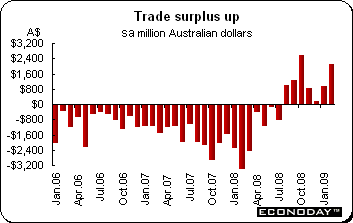 February merchandise trade surplus rose to A$2.1 billion, an increase of $1.2 billion on a revised surplus in January 2009. The increase was primarily due to the strong increase in goods and services exports, mainly in non-rural and other goods. Exports were up 4.4 percent on the month. Other goods were up 49 percent and were driven by the non-monetary gold component which jumped 55 percent. Rural goods were up 6 percent. Services edged up 1 percent. Imports were down 0.6 percent. Consumption goods imports sank by 13 percent while intermediate and other merchandise goods dropped 5 percent. However, other goods jumped 43 percent while capital goods were up 7 percent. February merchandise trade surplus rose to A$2.1 billion, an increase of $1.2 billion on a revised surplus in January 2009. The increase was primarily due to the strong increase in goods and services exports, mainly in non-rural and other goods. Exports were up 4.4 percent on the month. Other goods were up 49 percent and were driven by the non-monetary gold component which jumped 55 percent. Rural goods were up 6 percent. Services edged up 1 percent. Imports were down 0.6 percent. Consumption goods imports sank by 13 percent while intermediate and other merchandise goods dropped 5 percent. However, other goods jumped 43 percent while capital goods were up 7 percent.
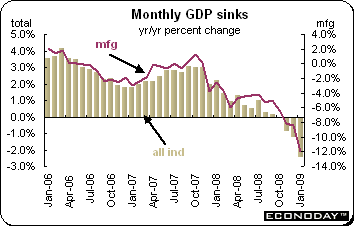 January monthly gross domestic product dropped 0.7 percent and was down 2.5 percent when compared with last year. The latest drop reflected weakness mainly in the goods producing area where activity contracted 1.9 percent on the month. Within this, manufacturing was especially soft, posting a 3.1 percent drop thanks to export oriented industries. Other categories that declined included construction (down 3.0 percent), utilities (down 0.4 percent) and mining & oil & gas extraction (down 0.2 percent). However agriculture, forestry & fishing increased 0.5 percent. Services deteriorated 0.2 percent on the month and 0.4 percent on the year. Weakness here was especially prominent in wholesale where output dropped 3.4 percent from December. Other declines included transportation & warehousing which were down 0.7 percent and food & accommodation which were off 0.6 percent. The winners in this sector were dominated by retail (1.4 percent) and arts, entertainment & recreation (1.2 percent). January monthly gross domestic product dropped 0.7 percent and was down 2.5 percent when compared with last year. The latest drop reflected weakness mainly in the goods producing area where activity contracted 1.9 percent on the month. Within this, manufacturing was especially soft, posting a 3.1 percent drop thanks to export oriented industries. Other categories that declined included construction (down 3.0 percent), utilities (down 0.4 percent) and mining & oil & gas extraction (down 0.2 percent). However agriculture, forestry & fishing increased 0.5 percent. Services deteriorated 0.2 percent on the month and 0.4 percent on the year. Weakness here was especially prominent in wholesale where output dropped 3.4 percent from December. Other declines included transportation & warehousing which were down 0.7 percent and food & accommodation which were off 0.6 percent. The winners in this sector were dominated by retail (1.4 percent) and arts, entertainment & recreation (1.2 percent).
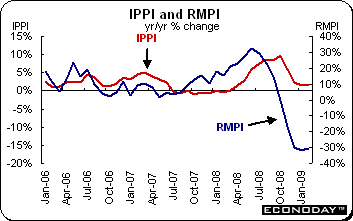 February industrial product price index was up 0.4 percent and 1.6 percent when compared with last year. The entire monthly advance was due to weakness in the Canadian dollar, without which the IPPI would have been unchanged. Petroleum & coal products were up a modest 0.4 percent. However, primary metal products were up 2.2 percent), motor vehicles & other transportation equipment climbed by 1.1 percent and lumber & other wood products increased by 0.8 percent. February raw material price index was up 1.7 percent but declined 30.7 percent on the year. Mineral fuels prices jumped by 4.8 percent on the month. Excluding this sector, the RMPI would have fallen 0.4 percent. February industrial product price index was up 0.4 percent and 1.6 percent when compared with last year. The entire monthly advance was due to weakness in the Canadian dollar, without which the IPPI would have been unchanged. Petroleum & coal products were up a modest 0.4 percent. However, primary metal products were up 2.2 percent), motor vehicles & other transportation equipment climbed by 1.1 percent and lumber & other wood products increased by 0.8 percent. February raw material price index was up 1.7 percent but declined 30.7 percent on the year. Mineral fuels prices jumped by 4.8 percent on the month. Excluding this sector, the RMPI would have fallen 0.4 percent.
G20 captured investors’ attention for most of last week, but there were important economic data as well. In Japan, investors were expecting the worst and got it in the industrial production and Tankan reports. And in Australia the trade surplus jumped thanks to rising exports. In Europe, the data continued to be morose although the PMI reports showed signs of bottoming, albeit at very low levels. And the European Central Bank surprised and lowered its key interest rate by only 25 basis points instead of the 50 expected by most analysts.
This week brings meetings of the Reserve Bank of Australia and the Banks of Japan and England and a plethora of industrial output data in Europe. Only the RBA has room to maneuver — the Banks of Japan and England do not.
| Central Bank activities |
|
| April 7 |
Australia |
Reserve Bank of Australia Monetary Policy Meeting |
| April 6, 7 |
Japan |
Bank of Japan Monetary Policy Meeting |
| April 8,9 |
UK |
Bank of England Monetary Policy Meeting |
|
|
|
| The following indicators will be released this week... |
| Europe |
|
|
| April 6 |
EMU |
Retail Sales (February) |
|
|
Producer Price Index (February) |
| April 7 |
EMU |
Gross Domestic Product (Q4.08 final) |
|
UK |
Industrial Production (February) |
| April 8 |
Germany |
Merchandise Trade (February) |
|
|
Manufacturing Orders (February) |
|
France |
Merchandise Trade (February) |
| April 9 |
Germany |
Industrial Production (February) |
|
Italy |
Industrial Production (February) |
|
UK |
Producer Price Index (March) |
| April 10 |
France |
Industrial Production (February) |
|
|
|
| Asia/Pacific |
|
|
| April 6 |
Australia |
Merchandise Trade Balance (February) |
| April 9 |
Australia |
Unemployment Rate (March) |
|
|
|
| Americas |
|
|
| April 6 |
Canada |
Ivey PMI (March) |
| April 9 |
Canada |
Employment (March) |
|
|
International Trade (February) |
Anne D Picker is the author of International Economic Indicators and Central Banks.
|

